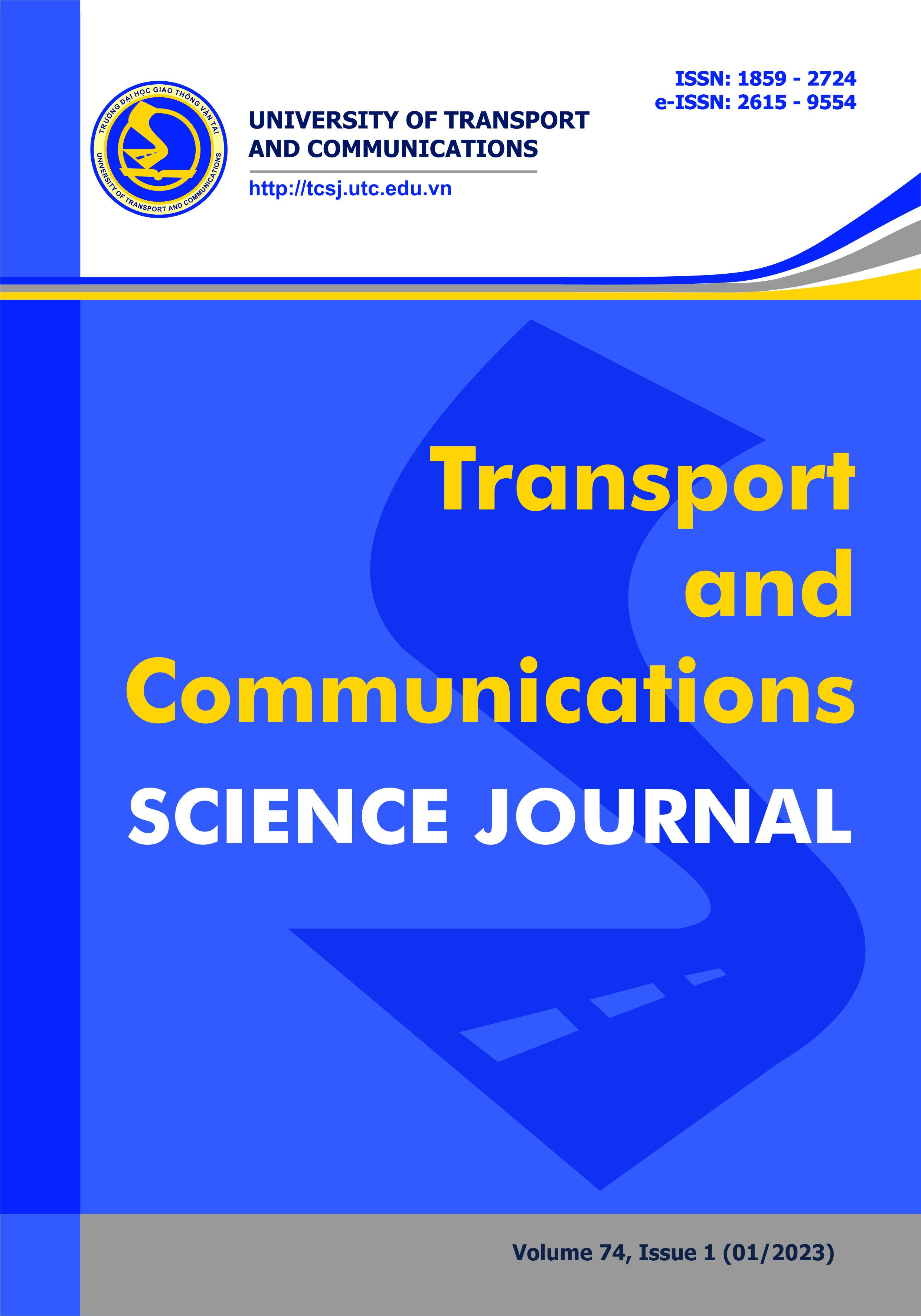Structural and thermal investigations of rolling tires in a flat road
Email:
congnt@utc.edu.vn
Từ khóa:
Tire structure, thermal investigation, rolling tires, friction heat, ANSYS ICEM
Tóm tắt
Rubber is an essential component of a pneumatic tire. In general, the tire, or the rubber part, is heated by the hysteresis effects caused by the deformation of the rubber part during the operation. Besides, the tire temperature depends on many factors, such as inflation pressure, vehicle loading, car speed, road tire, environment condition, and tire geometry, etc. This study focuses on the finite element approach to compute by simulating the temperature distributions of a steady-state rolling tire. For simplicity, the tire is assumed to be composed of rubber, body-ply, wire, and rim only. The nonlinear mechanical behavior of the rubber is characterized by a Mooney–Rivlin model, while the other parts are assumed to be a linear elastic material. The coupled effects of the inflation pressure and vehicle loading are investigated. Hysteresis energy loss is used as a bridge to link the strain energy density to the heat source in rolling tires. The steady-state thermal analysis may obtain the temperature distribution of rolling tires. On the other hand, an efficient computational process is being introduced to decrease the time for coupled 3D dynamic rolling simulation of the tire. The simulation results show that loading is the main factor in determining the temperature fieldTài liệu tham khảo
[1]. T. G. Ebbott, R. L. Hohman, J. P. Jeusette, V. Kerchman, Tire temperature and rolling resistance prediction with finite element analysis, Tire Science & Technology, 27 (1999) 2-21. https://doi.org/10.2346/1.2135974
[2]. K. K. Kar, A. K. Bhowmick, Hysteresis loss in filled rubber vulcanizates and its relationship with heat generation, Journal of Applied Polymer Science, 64 (1997) 1541-1555. https://doi.org/10.1002/(SICI)1097-4628(19970523)64:8<1541::AID-APP12>3.0.CO;2-0
[3]. D. M. Park, W. H. Hong, S. G. Kim, H. J. Kim, Heat generation of filled rubber vulcanizates and its relationship with vulcanizate network structures, European Polymer Journal, 36 (2000) 2429-2436. https://doi.org/10.1016/S0014-3057(00)00020-3
[4]. H. C. Park, S. K Youn, T. S. Song, N. J. Kim, Analysis of temperature distribution in a rolling tire due to strain energy dissipation, Tire Science & Technology, 25 (1997) 214-228. https://doi.org/10.2346/1.2137541
[5]. A. R. Johnson, Coupled thermo-mechanical analysis of dynamically loaded rubber cylinders, Proc. of 32nd International SAMPE Technical Conference, Boston, USA (2000).
[6]. Q. Kan, G. Kang, W. Yan, Y. Zhu, H. Jiang, A thermo mechanically coupled cyclic plasticity model at large deformations considering inelastic heat generation, Proc. of 13th International Conference on Fracture, Beijing, China (2013).
[7]. R. K. Luo, X. P. Wu, A. Spinks, Heat generation analysis of a rubber wheel using the steady-state transport analysis capability in abaqus, Proc. of SIMULIA Customer Conference, London, England (2009).
[8]. T. Tang, D. Johnson, E. Ledbury, T. Goddette, S. D. Felicelli, Simulation of thermal signature of tires and tracks, Proc. of Ndia Ground Vehicle Systems Engineering and Technology Symposium, Michigan, USA (2012).
[9]. S. K. Clark (Ed.). Mechanics of pneumatic tires. US Government Printing Office (1981).
[10]. Gehman, S. D. Material characteristics in mechanics of pneumatic tires, in: Clark S. K. (Ed.) (1981). Mechanics of Pneumatic Tires, Office of Vehicle Systems Research, Institute for Applied Technology and National Bureau of Standards, US Department of Commerce, Washington, pp. 1–40.
[11]. Truong Manh Hung, Nguyen Thanh Cong, Research on the application of Ansys software to determining Automobile tire durability in Vietnam, Transport and Communications Science Journal, 3 (2021), 242-250. https://doi.org/10.47869/tcsj.72.3.1
[12]. Y. J. Lin, S. J. Hwang, Temperature prediction of rolling tires by computer simulation, Mathematics and Computers in Simulation, 67 (2004) 235-249. https://doi.org/10.1016/j.matcom.2004.07.002
[2]. K. K. Kar, A. K. Bhowmick, Hysteresis loss in filled rubber vulcanizates and its relationship with heat generation, Journal of Applied Polymer Science, 64 (1997) 1541-1555. https://doi.org/10.1002/(SICI)1097-4628(19970523)64:8<1541::AID-APP12>3.0.CO;2-0
[3]. D. M. Park, W. H. Hong, S. G. Kim, H. J. Kim, Heat generation of filled rubber vulcanizates and its relationship with vulcanizate network structures, European Polymer Journal, 36 (2000) 2429-2436. https://doi.org/10.1016/S0014-3057(00)00020-3
[4]. H. C. Park, S. K Youn, T. S. Song, N. J. Kim, Analysis of temperature distribution in a rolling tire due to strain energy dissipation, Tire Science & Technology, 25 (1997) 214-228. https://doi.org/10.2346/1.2137541
[5]. A. R. Johnson, Coupled thermo-mechanical analysis of dynamically loaded rubber cylinders, Proc. of 32nd International SAMPE Technical Conference, Boston, USA (2000).
[6]. Q. Kan, G. Kang, W. Yan, Y. Zhu, H. Jiang, A thermo mechanically coupled cyclic plasticity model at large deformations considering inelastic heat generation, Proc. of 13th International Conference on Fracture, Beijing, China (2013).
[7]. R. K. Luo, X. P. Wu, A. Spinks, Heat generation analysis of a rubber wheel using the steady-state transport analysis capability in abaqus, Proc. of SIMULIA Customer Conference, London, England (2009).
[8]. T. Tang, D. Johnson, E. Ledbury, T. Goddette, S. D. Felicelli, Simulation of thermal signature of tires and tracks, Proc. of Ndia Ground Vehicle Systems Engineering and Technology Symposium, Michigan, USA (2012).
[9]. S. K. Clark (Ed.). Mechanics of pneumatic tires. US Government Printing Office (1981).
[10]. Gehman, S. D. Material characteristics in mechanics of pneumatic tires, in: Clark S. K. (Ed.) (1981). Mechanics of Pneumatic Tires, Office of Vehicle Systems Research, Institute for Applied Technology and National Bureau of Standards, US Department of Commerce, Washington, pp. 1–40.
[11]. Truong Manh Hung, Nguyen Thanh Cong, Research on the application of Ansys software to determining Automobile tire durability in Vietnam, Transport and Communications Science Journal, 3 (2021), 242-250. https://doi.org/10.47869/tcsj.72.3.1
[12]. Y. J. Lin, S. J. Hwang, Temperature prediction of rolling tires by computer simulation, Mathematics and Computers in Simulation, 67 (2004) 235-249. https://doi.org/10.1016/j.matcom.2004.07.002
Tải xuống
Chưa có dữ liệu thống kê

Nhận bài
10/08/2022
Nhận bài sửa
18/10/2022
Chấp nhận đăng
26/11/2022
Xuất bản
15/01/2023
Chuyên mục
Công trình khoa học
Kiểu trích dẫn
Thanh Cong, N., Khanh Duy Do, C., & Cong Truong, D. (1673715600). Structural and thermal investigations of rolling tires in a flat road . Tạp Chí Khoa Học Giao Thông Vận Tải, 74(1), 47-57. https://doi.org/10.47869/tcsj.74.1.5
Số lần xem tóm tắt
380
Số lần xem bài báo
231









